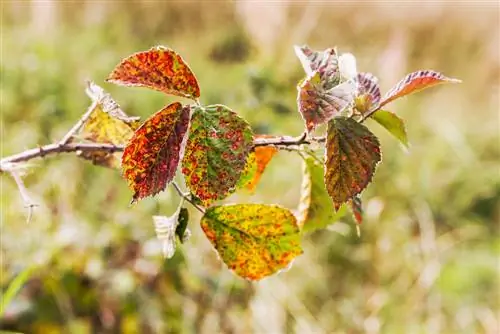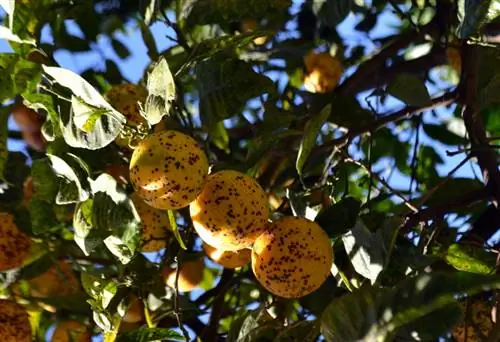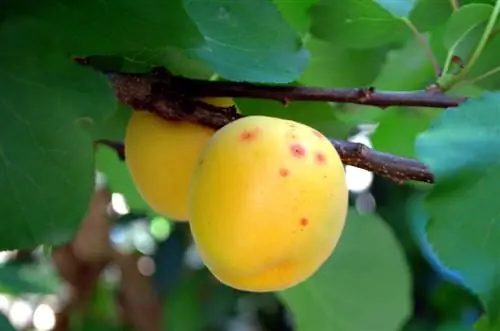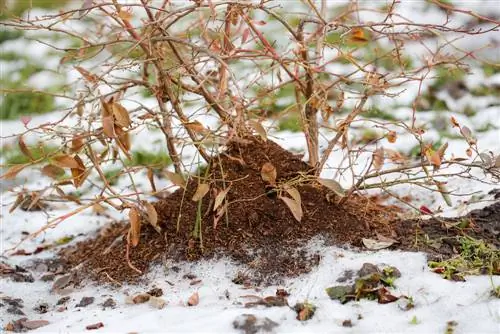- Author admin [email protected].
- Public 2023-12-26 14:17.
- Last modified 2025-06-01 06:02.
Rose rust is one of the most common rose diseases. The fungal disease is unmistakable due to the characteristic orange to brownish pustules on the undersides of the leaves. In this article we will explain to you how to treat the infection correctly and effectively prevent it in the future.
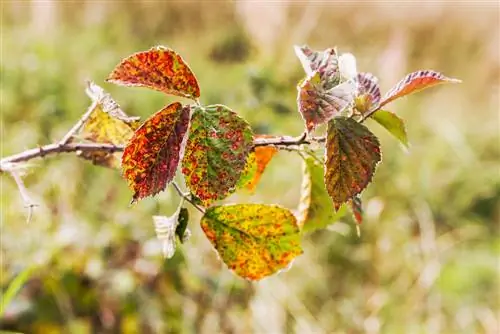
How can you recognize and combat rose rust?
Rose rust is a fungal disease that causes orange pustules on the undersides of rose leaves. To combat it, remove affected plant parts, dispose of them in household or organic waste and spray the roses with field horsetail broth. As a preventative measure, we recommend sufficient plant spacing, regular pruning and resistant ADR rose varieties.
- Rose rust is initially identified by orange pustules on the undersides of the leaves. These only later turn black.
- The spores overwinter on leaves, shoots and on the ground. In the following year, a renewed infection is likely if countermeasures are not taken.
- Remove affected plant parts and dispose of them with household or organic waste.
- Inject with field horsetail broth for treatment and prevention.
What is rose rust?
Rose rust is a typical rose disease caused by fungi of the species Phragmidium mucronatum or Phragmidium tuberculatum. These fungi remain permanently on a plant once colonized and overwinter on it. This means that if you don't control an infestation, it can recur every year.
Like all rust fungi, rose rust is stubborn. Towards the end of summer, numerous permanent spores form in the now black pustules, which are mainly found on the leaves and on woody shoots and spend the winter there. Here they lie dormant until around the end of March, when the new leaves sprout and infect them too. In addition, the fungal spores are so fine that the wind disperses them, further spreading the disease. They also end up on the ground with the fall leaves in autumn. Rose rust begins to germinate in damp weather and forms many spore deposits very quickly.
Identify rose rust in good time
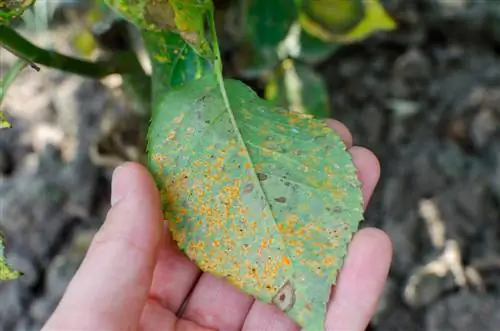
Rose rust begins on the underside of the leaf
In the early stages, rose rust can only be seen if you look very closely and especially look at the undersides of the leaves. For a long time nothing can be seen from above and the rose appears completely he althy, while numerous tiny orange bumps have long since formed on the undersides of the leaves. Only later on and when the summer camps turn black in late summer can light to blackish leaf discolorations be seen from above.
Damage and symptoms
You can recognize an infestation with rose rust by these symptoms:
- orange to orange-brownish, approximately pin-sized elevations, mostly on the undersides of the leaves
- can occasionally also appear on the upper sides of the leaves and on the shoots
- often (usually later) orange spots on the tops of the leaves
- Elevations and leaf coloring turn blackish-brown in late summer
Severely infected leaves may yellow and fall off.
How to distinguish star sooty mold from rose rust
Rose rust and star sooty mold are both fungal plant diseases that often occur on roses and are occasionally confused with each other. In contrast to rust disease, star sooty mold is a dangerous infection that can quickly result in the death of the rose. You can distinguish the disease from rose rust by these characteristics:
- Leaf spots are yellowish, brownish or black
- at the beginning isolated and very small spots
- typically have irregular and fringed edges
- grow very quickly in wet weather
- Morning dew also promotes growth
- Spots get bigger quickly
- Leaf yellows and falls off
To prevent star sooty mold (and other fungal diseases), you should regularly spray freshly made field horsetail broth as the leaves begin to emerge. A rhythm of 14 days is ideal. Diluted whole milk or sodium bicarbonate are also very suitable for prevention. You can buy products based on copper or sulfur for this purpose commercially.
Follow
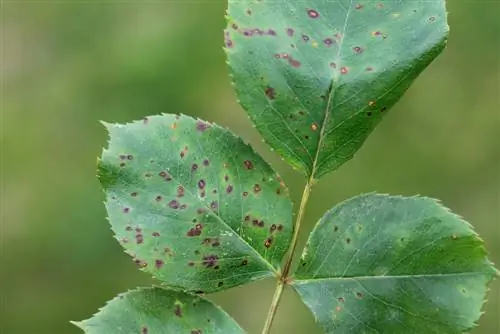
Rose rust is relatively harmless
“If you want roses to stay he althy and bloom beautifully, you have to cut them every year.”
Compared to other fungal diseases, rose rust is a harmless infection that initially only has negative effects on the appearance. It only becomes a problem if the infestation is very severe or if it occurs repeatedly over a period of years. In this case, complete leaf loss can occur and the rose is also weakened. This weakening in turn manifests itself in reduced growth and less flowering - the rose produces fewer or even no flowers at all. Very rarely the rose bush dies as a result of severe infestation.
Excursus
What other reasons are there for roses not blooming?
Roses are quite capricious flowers and generally only bloom when they feel comfortable. If only a few or no flowers are formed, this can have various reasons. In addition to diseases such as rose rust, pest infestation (e.g. aphids), an unsuitable location, incorrect care or incorrect pruning - in which the bud-forming shoots are cut off - lead to a lack of flowering. Furthermore, roses cannot tolerate damp weather or soil that is too wet and react to this with reduced flower production.
Fighting rose rust successfully - methods and remedies
When the weather is favorable, the fungal spores spread very quickly and infect other roses in the garden. In order to avoid further spread and infection, you should quickly take countermeasures. Especially in the early stages, you can avoid fungicides for rose rust, as various home remedies can be used just as well. We will explain to you in this section what these are and what treatment options you still have.
Proven home remedies
A spray with field horsetail broth is very effective against rose rust and other fungal diseases (e.g. powdery mildew). You can spray this every 14 days from the beginning of budding in mid to late March or in the event of a specific infection. For a preventative treatment, dilute the decoction with soft water in a ratio of 1:5, but for a fungal treatment, spray it undiluted.
Horsetail broth recipe:
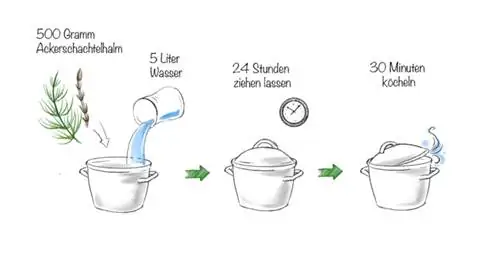
- collect fresh field horsetail
- Chop 500 grams very finely, then the ingredients will wash out better
- alternatively use 150 grams of dried herb
- let it steep in five liters of soft water for 24 hours
- then simmer at low temperature for half an hour
- let cool and strain
Pour the fresh brew into a spray container and spray your roses with it. Especially treat the undersides of the leaves; they must be dripping wet. It is best to spray early in the morning on a warm day so that the moisture can dry quickly.
You can also make fern or garlic broth in the same way, which are also good for combating or preventing rose rust. For the fern broth you should collect bracken or worm fern, both of which often grow like carpets in moist mixed forests. For the garlic broth, use whole garlic cloves including skin and leaves, not just individual cloves.
Tip
Baking soda also helps against fungal diseases such as rose rust and black mold. Mix two teaspoons of pure baking soda (e.g. caustic soda or baking soda, but not baking powder!) with one liter of warm water and use the mixture as a spray. You can also sharpen it as a preventive measure. However, adding cooking oil and dishwashing liquid (as often described) is not necessary.
Biological and chemical sprays
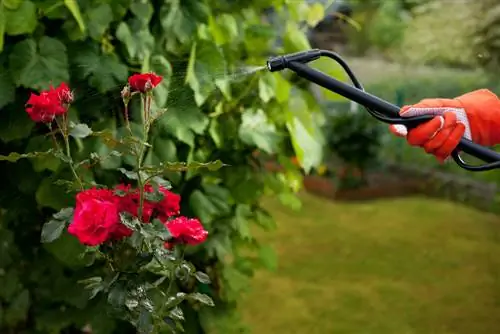
The use of fungicides is generally not recommended
Various fungicides are available commercially that can be used in the event of an acute rose rust infestation. But be careful: Do not use these products repeatedly over a period of weeks, otherwise the fungi will become resistant to them. Therefore, change the active ingredient group regularly. The following sprays are approved for hobby gardens:
- Compo Ortiva (contains azoxystrobin)
- Fungisan rose and vegetable mushroom-free (contains azoxystrobin)
- Compo Duaxo (contains difenoconazole)
- Celaflor rose fungus-free Saprol (contains triticonazole)
You must not inject the first two and the last two products one after the other, as they belong to the same group of active ingredients. You should also only carry out treatment with fungicides until flowering begins, as the ingredients affect bees and other beneficial insects.
In any case, you should think carefully about the use of fungicides and only use them if there are no alternatives. These agents have significant side effects, not only on the ecological balance - they are simply highly toxic and should therefore be avoided if possible. However, it is better (although not optimal) to use sprays such as copper or sulfur. These are also approved in organic farming against a variety of fungal plant diseases.
Further measures
If you notice the characteristic pustules on the rose petals, you should act immediately. The first steps to take are these tasks:
- Remove all infected leaves.
- Cut back the infected shoots and branches.
- Pick up fallen leaves from the ground.
- If there is a severe infestation, remove the top layer of soil.
- Fungal spores can also hide here.
All plant parts and the removed soil belong in the household or organic waste. Under no circumstances should you leave them in the garden, as the fungal spores will spread further from here. Further treatment will only take place afterwards.
Effective prevention against rose rust

Better than applying toxic pesticides in the home and hobby garden is careful prevention so that rose rust does not appear in the first place. These measures will help you prevent infection in the first place:
- Location: Roses thrive in sunny, airy locations with humus-rich, loose soil.
- Planting distance: Make sure there is sufficient planting distance when planting, as fungal diseases can spread more easily in plantings that are too close.
- Regular pruning: For the same reason, regular pruning makes sense, because moisture dries out more quickly in loose, airy crowns and bushes. How to reduce the risk of infection.
- Spring pruning: Roses are generally pruned when the forsythia blooms. Take this opportunity to remove infected shoots and branches so that the new leaves do not come into contact with the spores.
- Fertilization: Fertilization with a strong nitrogen content makes the plant material soft and therefore susceptible to the penetration of fungal and other pathogens. Therefore, fertilize in a balanced way and save nitrogen. Potassium, on the other hand, is good because this nutrient strengthens the cell walls.
- Watering: In dry times - especially in spring and summer - you should keep the soil evenly moist, as dryness weakens the rose. Always water directly onto the soil and never over the leaves - wet leaves are a source of infection!
- Mulching: In autumn, mulch the root disc with wood chips and horn shavings or humus-rich potting soil. This will prevent fungal spores on the ground from getting onto the plant.
- Leaves: Remove the autumn leaves and dispose of them.
Infected clippings and fallen leaves do not belong in the compost, as the temperatures here are usually not high enough to reliably kill the fungal spores.
Planting resistant rose varieties
If you want to be on the safe side and avoid fungal diseases, plant so-called ADR roses in the garden. These are modern breeds that have been tested over the years for their resistance to the common rose diseases rose rust, powdery mildew and star sooty mildew and have proven to be particularly resistant. But be careful: resistant does not mean that these roses cannot contract fungal diseases at all - of course they still can, even if infection is less likely.
In addition to the ADR varieties, you should take preventative measures. An optimal location as well as a balanced fertilization and water supply help to avoid a fungal infection. Of course, an outbreak can still occur in wet summers: in such cases, avoid using fungicides, as the fungi become resistant to them, change their genetic material and therefore the ADR varieties are no longer immune to their attacks. Their genetic material does not adapt to the changed fungal pathogens.
Frequently asked questions
Are there other plants that are affected by rose rust?
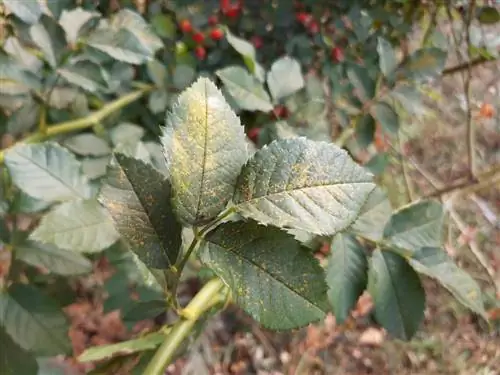
Rose rust only affects real roses
The fungal disease rose rust only affects real roses, not other plant species. However, there are a whole range of other rust fungi, each of which specializes in certain host plants. They all have the typical pustules in common, and the different varieties are also similar in terms of further damage and the measures to combat them.
Which diseases commonly occur on roses?
Roses are generally susceptible to various fungal diseases. In addition to rose rust, they are also often attacked by powdery mildew and star sooty mildew, although some varieties are less sensitive to these infections than others. Anyone who plants ADR roses chooses proven and resistant varieties.
Why do roses get rose rust?
Like so many fungal diseases, rose rust is transmitted through the air. The microscopic spores reach the plants with the wind and spread over the roses within a very short time. Sometimes the disease is also transmitted through newly purchased roses and planted in the borders if they were already diseased when purchased. Infestation cannot always be detected in the early stages of the disease.
Is rose rust also dangerous for humans?
Rose rust is annoying for humans, but completely harmless. It is a purely plant disease that does not affect humans or animals. However, you should refrain from eating roses infected with fungi - the fungal toxins they contain could cause symptoms such as a skin rash, at least in allergy sufferers.
Tip
Therefore, check your roses from the moment they sprout - approximately weekly - for any changes. This way you can not only detect rose rust, but also other diseases and pest infestations in good time.

